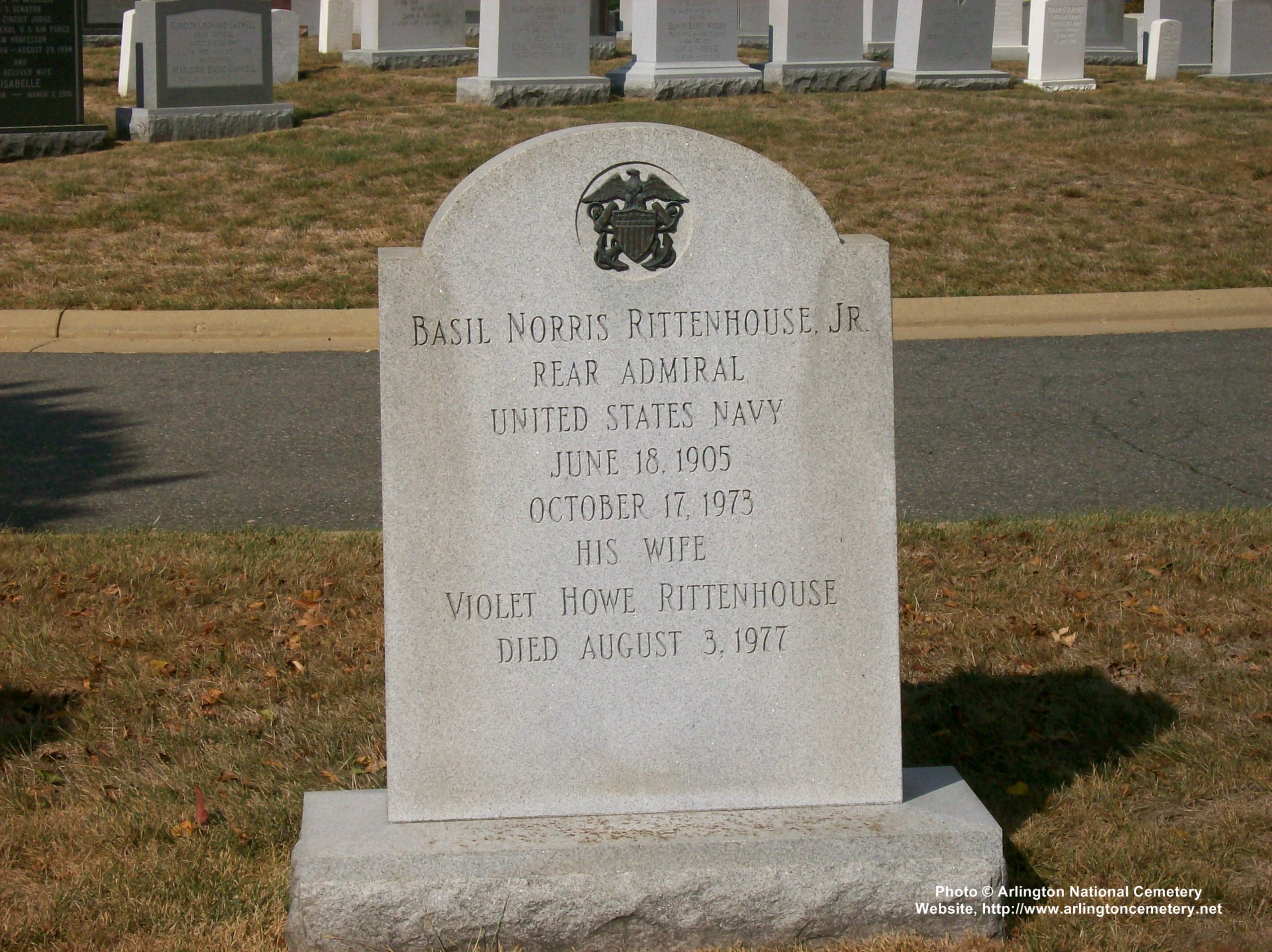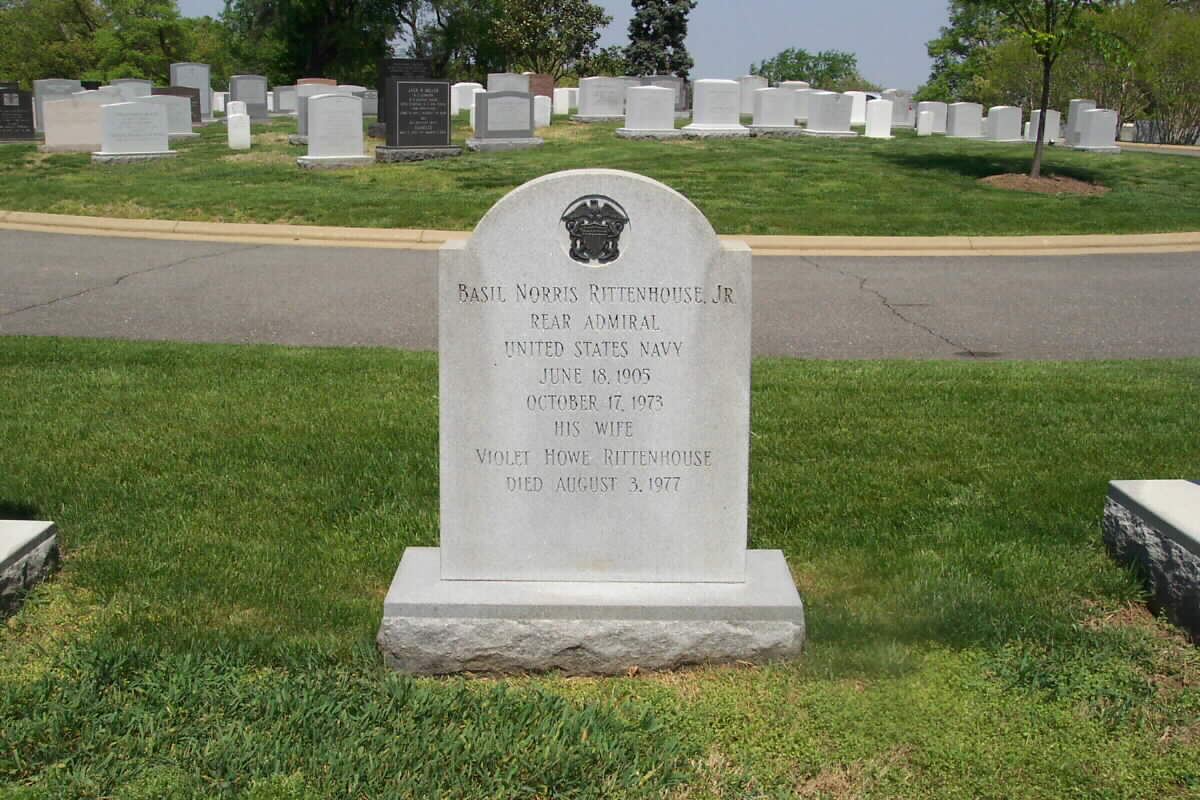Biographical Materials Courtesy of Dan McLain
REAR ADMIRAL BASIL N. RITTENHOUSE, JR.
UNITED STATES NAVY, RETIRED
Basil Norris Rittenhouse was born at Fort Riley, Kansas. He was appointed, at large, to the United States Naval Academy in 1924. As a Midshipman, he was a member of the Navy Rifle Team. He graduated and was commissioned an Ensign on 7 June 1928. He subsequently advanced in rank, attaining that of Captain on 25 March 1945. His selection for the rank of Rear Admiral was approved by the President of the United States on 17 July 1956, with a date of rank of 1 August 1956.
Following graduation from the Naval Academy in 1928, he remained there to serve with the Navy Rifle Team until September of that year. He then joined the USS Mississippi. He was aboard that battleship until January 1930, interspersed with duty, from May to September 1929, in connection with the Navy Rifle Team matches at Annapolis, Maryland, and Camp Perry, Ohio. He has a brief assignment in the Hydrographic Office, Department of the Navy, Washington, D.C., prior to reporting in February 1930 ob board the USS Niagara. In February 1931, he transferred to the USS Fulton and from December 1931 until July 1935 he served on the USS Chester, with temporary additional duty during this period with the Civilian Conservation Corps in the Eureka District of California.
Detached from the USS Chester, he next attended the Postgraduate School, Annapolis, Maryland, and upon completing his instruction in May 1936 remained in Annapolis to serve as an Aide to the Superintendent of the Naval Academy. In June 1938, he joined the USS Gridley and in December 1940 reported as Executive Officer on board the USS Cassin. Detached from the latter in September 1941, he was next assigned to the Bureau of Navigation (later the Bureau of Naval Personnel), Navy Department, Washington, D.C., where he continued to serve following the American entry into World War II, 8 December 1941. He then assumed command of the USS Mackenzie, commanding that destroyer during the advanced operations in Italy and the subsequent invasion of Southern France. He was awarded the Bronze Star and a Gold Star in lieu of a second Bronze Star, each with combat “V.” The citations (in part) follow:
Bronze Star Medal: “For meritorious achievement prior to and during the Amphibious Invasion of Southern France in August 1944. After bringing his ship to a high-peak of combat readiness in preparation for this vital operation he fought the MacKenzie as a unit of the fire-support group against the shore through mine-infested waters and in the face of heavy return fire, he delivered accurate and vigorous gunfire against enemy installations and concentrations, thereby contributing materially to the expeditious establishment of the beachhead and to the rapid advance of the assault forces.”
Gold Star in lieu of a second Bronze Star Medal: “For heroic achievement as Commanding Officer of the USS MacKenzie, during advanced operations in support of the Allied armies in Italy from 12 May to 2 June 1944. He led his ship in the screening of extensive fire-support operations in this area. Subsequently serving as Commander of a Task Unit assigned to the left flank, he directed accurate and concentrated fire against enemy shore installations and self-propelled guns despite accurate counter fire from hostile artillery, silencing several strong points and inflicting heavy damage on trucks and combat vehicles. By his courage and initiative, he contributed to the success of Allied armies in their breakthrough on the Cassino front and in their subsequent advance northward toward Rome.”
Detached from command of the MacKenzie in November 1944, he then became Commander of Destroyer Division Thirty-Two and in July 1945 transferred to command of Destroyer Division Twenty-Four. He served from December 1945 until July 1946 in the Bureau of Naval Personnel, Washington, D.C., after which he had an assignment at the Naval Academy. He remained there until June 1948 when he joined the staff of Commander, Task Force Eighty as Chief Staff Officer. He was in command of that Task Force from December 1948 until March 1949, after which he commanded the Resupply Group, Arctic Weather Stations (Nanook II), under the Chief of Naval Operations. In February 1949 he reported as Chief, Naval Section, Military Assistance Advisory Group to the Netherlands, at the Hague.
In September 1951, he was assigned to the Office of the Chief of Naval Operations, Navy Department, Washington, D.C., where he served as Head of the Foreign Military Rights Branch and later as Assistant to the Navy Member of the Department of Defense Management Council. He continued duty there until September 1953 and the next month reported as Commander, Transport Division Fourteen. For meritorious service during the operation “Passage to Freedom,” while serving as Commander, Debarkation Group from 16 to 24 August 1954 and Commander, Debarkation Group from 26 August to 3 October 1954, he received a Letter of Commendation, with authorization to wear the Commendation Ribbon, from the Secretary of the Navy. The citation, in part, reads:
“Displaying exceptional initiative and ability, Captain Rittenhouse planned and conducted the initial embarkation of Vietnamese refugees and equipment through the port of Haiphong, Indo-China. During this period, he coordinated the intricate and unique shore-to-ship movement of men, women, children and equipment exercising excellent judgment, diligence and professional skill.”
From October 1954 to July 1955, he was Commander, Amphibious Squadron Nine, also serving during that period as Commander, Transport Divisions Ninety-One and Ninety-Two. Following temporary duty in the Eleventh Naval District, San Diego, California, and the Office of Chief of Naval Operations, Navy Department, he reported in October 1955 as Chief of the Navy Section, Military Assistance, Advisory Group, Spain. On 26 October 1956, he assumed duty as Commander Military Sea Transport Service, Eastern Atlantic and Mediterranean Area, and on 10 October 1957 reported for duty as Director of the Foreign Military Assistance Division, Office of the Chief of Naval Operations. He was Commander, Amphibious Group Four from November 1959 until December 1960 when he became Deputy Chief of Staff to the Commander, United States Forces, Japan (this title was later changed to Chief of Staff, Headquarters, U. S. Forces (Japan). He had brief duty in the Bureau of Naval Personnel and in the Washington, D.C. area from 31 October 1961 until relieved of all active duty pending his retirement, effective 16 December 1961.
In addition to the Bronze Star Medal with Gold Star and Combat “V,” and the Commendation Ribbon, Rear Admiral Rittenhouse has the American Defense Service Medal, Fleet Clasp; the American Campaign Medal; the European-African-Middle Eastern Campaign Medal; the Asiatic-Pacific Campaign Medal; the World War II Victory Medal; the Navy Occupation Service Medal, Asia Clasp; the China Service Medal; and the National Defense Service Medal.
OBITUARY
RETIRED ADMIRAL BASIL N. RITTENHOUSE, JR., 68
Retired Navy Rear Admiral Basil N. Rittenhouse, Jr., 68, a career officer with 33 years of service, died Wednesday at Bethesda Naval Hospital after a long illness.
Although he was born at Fort Riley, Kansas, while his father, an Army officer, was stationed there, Admiral Rittenhouse considered himself a fourth-generation Washingtonian.
He attended Columbia Preparatory School here and graduated from the United States Naval Academy at Annapolis in 1928.
Much of his duty was at sea, his first assignment being on the battleship USS Mississippi. But his sea duty was interspersed at times to permit him, as a member of the Navy rifle team, to participate in rifle matches.
He also saw duty in Washington before World War II.
In 1943, Admiral Rittenhouse assumed command of the destroyer USS Mackenzie and took that ship into advanced operations in Italy and the subsequent invasion of Southern France.
Later duties involved commanding transport divisions in which he planned and conducted embarkation of Vietnamese refuges, serving as chief of the Navy section of the Military Assistance Group in Spain and commanding the Military Sea Transportation Service for the Eastern Atlantic and Mediterranean Area.
In 1957, Admiral Rittenhouse reported back to the Navy Department here as director of the foreign military assistance division in the office of the Chief of Naval Operations.
In 1960, Admiral Rittenhouse was named deputy chief of staff to the commander of U. S. Forces in Japan. This was followed by brief duty in the Bureau of Navy Personnel here before his retirement at the end of 1961.
Admiral Rittenhouse had lived at 1870 Wyoming Avenue, N. W. since his retirement.
He is survived by his wife, Violet, and a sister, Mrs. Lanier Gray, of Alexandria, Virginia.
Lieutenant Colonel Basil Norris Rittenhouse, United States Army, married Marie Louise Tucker on 12 November 1901 in Washington, D.C. They had the following children: Basil Norris Rittenhouse Jr. was born 18 June 1905 in Fort Riley, Kansas, Elizabeth Beverly Rittenhouse was born 10 December 1907 in Fort Ethan Allen, Vermont.
Admiral Rittenhouse died on 17 October 1973 and was buried with full military honors in Section 3 of Arlington National Cemetery. His wife, Violet Howe Rittenhouse died on 3 August 1977 and was buried with him. His father, Basil Norris Rittenhouse Sr. is buried nearby in Arlington National Cemetery.
We are actively seeking additional information regarding these individuals.
Michael Robert Patterson was born in Arlington and is the son of a former officer of the US Army. So it was no wonder that sooner or later his interests drew him to American history and especially to American military history. Many of his articles can be found on renowned portals like the New York Times, Washingtonpost or Wikipedia.
Reviewed by: Michael Howard


